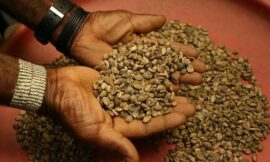The acidity of coffee depends greatly on the roasting process. As coffee beans are roasted, their organic acids break down, reducing the overall acidity and brightness of the coffee. However, some acidity is desirable in creating a balanced, flavorful cup of coffee.
In green coffee beans, the main organic acids that contribute to acidity include:
- Citric acid:
Provides a bright, tart acidity. Found in high amounts in lightly roasted coffees. - Malic acid:
Contributes a crisp, apple-like acidity. Also found in high amounts in light roasts. - Quinic acid:
Responsible for a subtle, tangy acidity. Decreases significantly during roasting. - Acetic acid:
Formed during roasting through the breakdown of other acids. Acetic acid adds a vinegar-like tang in small amounts but can taste sour in high amounts, especially in dark roasts.
How acidity is affected as coffee beans are roasted:
- Light roasts (cinnamon roast, New England roast):
Shorter roasting times and lower temperatures preserve more organic acids, resulting in a bright, acidic flavor. The tart, fruity acids are balanced by the natural sweetness of the beans. - Medium roasts (American roast, City roast):
Moderate roasting causes some acid breakdown, decreasing brightness while still retaining a balanced acidity. The flavor shifts from tart and fruity to smokey and caramel-like. - Dark roasts (French roast, Continental roast):
Longer roasting times and higher temperatures cause significant acid breakdown, resulting in a bold, smoky flavor with little acidity. The dark, oily beans have a bitter, slightly sour taste from compounds formed during advanced stages of roasting. - Very dark roasts (New Orleans roast, Espresso roast):
Prolonged roasting results in nearly complete acid breakdown. The beans develop an oily surface and a harsh, burnt flavor due to the formation of acetic acid and other byproducts. Virtually no acidity remains.
Balancing Acidity in Coffee Beans: A Roaster’s Skill
The level of acidity in any given coffee depends on where the roaster chooses to stop the roasting process. The skill of the roaster lies in achieving the optimal level of acidity for any particular coffee. For most specialty coffees, a balance of acidity and body is ideal. By under-roasting or over-roasting the beans, the roaster risks creating a coffee that is too acidic and sour or too bitter and harsh.
Acidity and type of beans
The level of acidity also depends on the type of coffee bean and where it was grown. The two most common coffee beans are arabica and robusta, with arabica having lower acidity than robusta. Similarly beans, like Kenyan and Ethiopian coffees, naturally have higher acidity, while others, like Sumatran and Costa Rican coffees, have lower acidity. The natural acidity of the bean interacts with the roasting process to create the coffee’s unique flavor profile.
Here is a general list of regions in order of high acidity to low acidity:
- Kenya
- Ethiopia
- Tanzania
- Colombia
- Costa Rica
- Panama
- El Salvador
- Guatemala
- Honduras
- Nicaragua
- India
- Sumatra
- Brazil
Please note that this list is not exhaustive and only provides a general idea of the acidity levels in coffee beans from these regions. The acidity of coffee beans can vary within each region due to factors such as altitude, soil composition, and processing methods.
In the end, acidity is a crucial component of a balanced, enjoyable cup of coffee. Through skillful roasting, the organic acids in the beans can be transformed into a flavor that is bright and complex without being too sour. The perfect level of acidity depends on the preferences of the consumer and achieving it is part art and part science. For most coffee lovers, a blend of acidity and body, created through a medium roast, results in an ideal, flavorful brew. However, no matter the roast, the organic acids found within the coffee beans are responsible for providing the tangy, vibrant quality we refer to as acidity.
Read our article Coffee Roasting: The Science And How It Affects Flavor, to know about the other factors and science responsible for the final flavor of your coffee ☕️.




